Dietary Disruptors in Romania: Seasonality, Traditions, and the COVID-19 Pandemic
Abstract
:1. Introduction
2. Materials and Methods
2.1. Study Population and Data Collection
2.2. The Set of Variables Used in the Data Analysis
2.3. Data Analysis
- (a)
- The static fixed effects panel model (FE) has the following form:
- (b)
- The dynamic panel models have the following form:
3. Results
3.1. Main Aspects Related to Food Consumption
3.2. Econometric Modeling and Main Outcomes
4. Discussion
5. Conclusions
Author Contributions
Funding
Institutional Review Board Statement
Informed Consent Statement
Data Availability Statement
Conflicts of Interest
Appendix A. Technical Details and Results of the Econometric Modelling
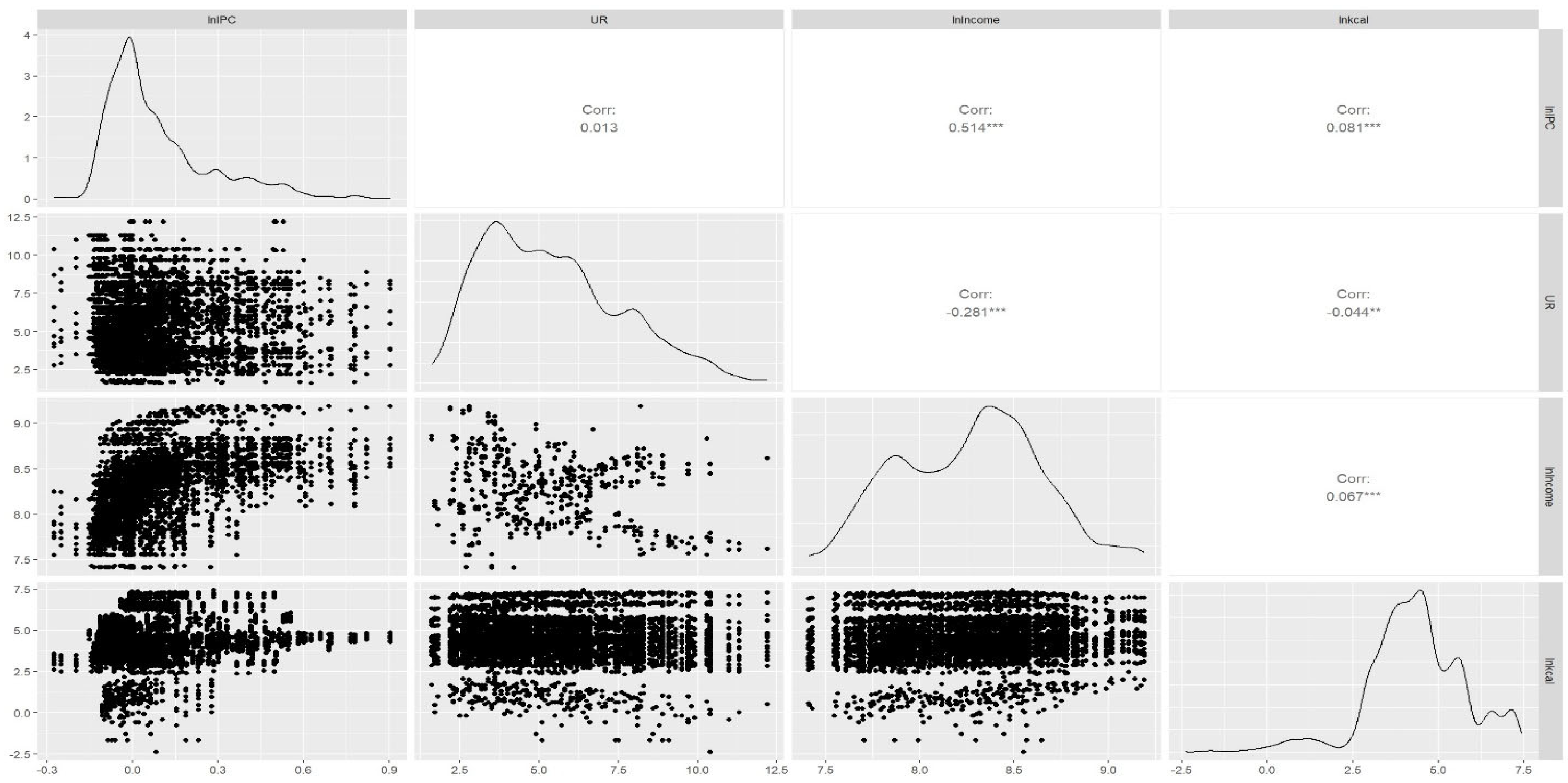
- H0: = 0; the unit root is present.
- H1: pi2 < 0; no unit root.
- H034: pi3 = pi4 = 0; the seasonal unit root is present.
- H134: at least pi3 or pi4 < 0; no seasonal unit root.
| HEGY Statistics | |||||||
|---|---|---|---|---|---|---|---|
| Dependent Variable | lncal | Consumer Price Index (CPI) | |||||
| Class | Category | t1 | t2 | F34 | t1 | t2 | F34 |
| Carbohydrates | Cereals | −2.44 | −2.58 * | 7.3 * | 1.39 | 0.06 | 1.68 |
| Water and non-alcoholic beverages | −2.13 | −2.50 * | 5.8 * | - | - | - | |
| Bread and bakery prod. | −2.50 | −3.02 * | 7.8 * | 1.14 | −1.12 | 3.16 | |
| Cornmeal | −2.97 * | −3.12 * | 8.1 * | 2.76 | 2.10 | 0.24 | |
| Flour | −3.80 * | −3.25 * | 11.8 * | 1.60 | −1.20 | 0.15 | |
| Fresh and canned vegetables | −2.79 * | −2.71 * | 8.5 * | −2.82 | −2.26 | 2.79 | |
| Fruits | −3.13 * | −3.09 * | 9.0 * | −1.19 | −0.74 | 3.63 | |
| Jam and compotes | −2.71 * | −2.96 * | 7.4 * | 2.88 | −0.22 | 1.29 | |
| Rice | - | - | - | 1.39 | 0.06 | 1.68 | |
| Potatoes | −2.12 | −2.06 | 4.9 | −3.16 | −1.28 | 3.22 | |
| Sugar products and sweets | −2.39 | −2.72 * | 5.6 * | 3.34 | 2.84 | 4.86 | |
| Sugar | −2.50 | −2.91 * | 8.5 * | 2.41 | 1.31 | 7.46 | |
| Proteins | Meat and meat products | −1.80 | −2.38 * | 6.5 * | 0.36 | −0.48 | 1.26 |
| Milk | −4.96 * | −3.34 * | 11.0 * | −2.01 | −1.31 | 2.29 | |
| Eggs | −3.18 * | −2.30 * | 9.4 * | −1.16 | −2.06 | 1.48 | |
| Fats | Cheese and cream | −2.57 * | −2.19 * | 5.4 | 1.55 | 1.67 | 0.87 |
| Fats | −25.6 * | −12.9 * | 195.7 * | −4.84 | −5.41 | 1.29 | |
| Sunflower, corn, and soybean oils | −2.96 * | −3.35 * | 11.5 * | −4.85 | −5.41 | 1.29 | |
| Variable | HEGY Statistics | ||||||
| t1 | t2 | F34 | |||||
| Income | −2.78 * | −1.78 | 7.93 * | ||||
| UR | −3.65 * | −2.37 * | 5.23 | ||||
| Derived critical values at p-value = 0.05 | −2.52 | −2.07 | 5.47 | ||||
References
- World Health Organization. European Regional Obesity Report 2022. Available online: https://iris.who.int/bitstream/handle/10665/353747/9789289057738-eng.pdf (accessed on 30 December 2024).
- Malik, V.S.; Willet, W.C.; Hu, F.B. Nearly a decade on—Trends, risk factors, and policy implications in global obesity. Nat. Rev. Endocrinol. 2020, 16, 615–616. [Google Scholar] [CrossRef] [PubMed]
- Eurostat. Overweight and Obesity—BMI Statistics. Available online: https://ec.europa.eu/eurostat (accessed on 13 August 2024).
- OECD; European Union. Health at a Glance: Europe 2022: State of Health in the EU Cycle; OECD Publishing: Paris, France, 2022. Available online: https://www.oecd-ilibrary.org/foreword_6df2007c-en.pdf (accessed on 30 December 2024).
- Virmasalo, I.; Hasanen, E.; Pyykonen, J.; Nurmi, M.; Simula, M.; Salmikangas, A.-K.; Muukkonen, P. Closed due to COVID-19: Effects of indoor sports restrictions on suburban adults’ physical activity behaviours. Int. J. Sport Policy Politics 2023, 15, 249–269. [Google Scholar] [CrossRef]
- Moosavi, J.; Fathollahi-Fard, A.; Dulebenets, M.A. Supply chain disruption during the COVID-19 pandemic: Recognizing potential disruption management strategies. Int. J. Disaster Risk Reduct. 2022, 75, 102983. [Google Scholar] [CrossRef] [PubMed]
- Lombardo, M.; Guseva, E.; Perrone, M.A.; Müller, A.; Rizzo, G.; Storz, M.A. Changes in eating habits and physical activity after COVID-19 pandemic lockdowns in Italy. Nutrients 2021, 13, 4522. [Google Scholar] [CrossRef]
- Cagla, A.; Celep, A.G.S. Assessment of dietary habits and use of nutritional supplements in COVID-19: A cross-sectional study. PharmaNutrition 2022, 22, 100309. [Google Scholar] [CrossRef]
- Năstăsescu, V.; Mititelu, M.; Stanciu, T.I.; Drăgănescu, D.; Grigore, N.D.; Udeanu, D.I.; Stanciu, G.; Neacșu, S.M.; Dinu-Pîrvu, C.E.; Oprea, E.; et al. Food habits and lifestyle of Romanians in the context of the COVID-19 pandemic. Nutrients 2022, 14, 504. [Google Scholar] [CrossRef] [PubMed]
- Dumitraș, D.E.; Harun, R.; Arion, F.H.; Chiciudean, D.I.; Kovacs, E.; Oroian, C.F.; Porutiu, A.; Muresan, I.C. Food consumption patterns in Romania during the COVID-19 pandemic. Foods 2021, 10, 2712. [Google Scholar] [CrossRef]
- Kinoshita, K.; Ozato, N.; Yamaguchi, T.; Bushita, H.; Sudo, M.; Yamashiro, Y.; Mori, K.; Katsuragi, Y.; Sasai, H.; Murashita, K.; et al. Association of the COVID-19 pandemic with changes in objectively measured sedentary behavior and adiposity. Int. J. Obes. 2023, 47, 375–381. [Google Scholar] [CrossRef] [PubMed]
- Voinea, L.; Vrânceanu, D.M.; Filip, A.; Popescu, D.V.; Negrea, T.M.; Dina, R. Research on food behavior in Romania from the perspective of supporting healthy eating habits. Sustainability 2019, 11, 5255. [Google Scholar] [CrossRef]
- Branley-Bell, D.; Talbot, C.V. Exploring the impact of the COVID-19 pandemic and UK lockdown on individuals with experience of eating disorders. J. Eat. Disord. 2020, 8, 44. [Google Scholar] [CrossRef]
- Philippe, K.; Chabanet, C.; Issanchou, S.; Monnery-Patris, S. Child eating behaviors, parental feeding practices, and food shopping motivations during the COVID-19 lockdown in France: (How) did they change? Appetite 2021, 161, 105132. [Google Scholar] [CrossRef] [PubMed]
- Lamy, E.; Viegas, C.; Rocha, A.; Lucas, M.R.; Tavares, S.; e Silva, F.C.; Guedes, D.; Laureati, M.; Zian, Z.; Machado, A.S.; et al. Changes in food behavior during the first lockdown of the COVID-19 pandemic: A multi-country study about changes in eating habits, motivations, and food-related behaviors. Food Qual. Prefer. 2022, 99, 104559. [Google Scholar] [CrossRef]
- Pouget, M.; Clinchamps, M.; Lambert, C.; Pereira, B.; Farigon, N.; Gentes, E.; Miolanne, M.; Picard, M.; Tyrode, A.; Alligier, M.; et al. Impact of COVID-19 lockdown on food consumption and behavior in France (COVISTRESS study). Nutrients 2022, 14, 3739. [Google Scholar] [CrossRef]
- Mora, T.; Fichera, E.; Lopez-Varcarcel, B. How has the strict lockdown during the SARS-CoV-2 outbreak changed the diet of Spaniards? SSM Popul. Health 2023, 17, 101512. [Google Scholar] [CrossRef] [PubMed]
- Parker, J.; Kaur, S.; Medalla, J.M.; Imbert-Sanchez, A.; Bautista, J. Dietary trends among young adults during the COVID-19 lockdown: Socioeconomic and gender disparities. BMC Nutr. 2023, 9, 107. [Google Scholar] [CrossRef]
- National Institute of Statistics. Tempo-Online, HBS Monthly Average Agro-Food Consumption per Person by Main Social Categories, Macroregions, and Development Regions. Path to Data: Social Statistics/A.5 Income and Living/13. Consumption, Matrix BUF113J. Available online: http://statistici.insse.ro:8077/tempo-online/#/pages/tables/insse-table (accessed on 30 December 2024).
- National Institute of Statistics. Household Budgets Survey Metadata. Available online: http://80.96.186.4:81/metadata/viewStatisticalResearch.htm?researchId=5352 (accessed on 13 December 2024).
- National Institute of Statistics. Household Budgets Survey, Coordonate ale Nivelului de Trai în România, 2022; p. 15. Available online: https://insse.ro/cms/sites/default/files/field/publicatii/coordonate_ale_nivelului_de_trai_in_romania_2022_0.pdf (accessed on 30 December 2024).
- Eurostat. Household Budget Surveys in the EU: Methodology and Recommendations for Harmonization. Available online: https://ec.europa.eu/eurostat/documents/3859598/5875361/KS-BF-03-003-EN.PDF.pdf/42a95cc0-cb48-48c7-8d3a-dfc5fa265eff?t=1414781029000 (accessed on 30 December 2024).
- United States Department of Agriculture (USDA). Available online: https://www.nal.usda.gov/human-nutrition-and-food-safety/nutrient-lists-standard-reference-legacy-2018 (accessed on 30 December 2024).
- National Institute of Statistics. Tempo-Online, HBS Monthly Averages of Total Income per Household, by Income Sources and Main Social Categories by Macroregions and Development Regions. Path to Data: Social Statistics/A.5 Income and Living/11. Income, Matrix BUF104J. Available online: http://statistici.insse.ro:8077/tempo-online/#/pages/tables/insse-table (accessed on 30 December 2024).
- National Institute of Statistics. Tempo-Online, Consumer Price Indices by Main Goods and Services—Monthly Evolution as Against Previous Month. Path to data: Social Statistics/A.5 Income and Living/11. Income, Matrix BUF104J. Available online: http://statistici.insse.ro:8077/tempo-online/#/pages/tables/insse-table (accessed on 30 December 2024).
- National Institute of Statistics. Tempo-Online, ILO Unemployment Rate by Age Group and Urban/Rural Area, by Macro-Regions and Development Regions. Path to Data: Social Statistics/A.4 Labour Force/7. ILO Unemployed-Household Labour Force Survey, Matrix AMG157E. Available online: http://statistici.insse.ro:8077/tempo-online/#/pages/tables/insse-table (accessed on 30 December 2024).
- European Central Bank (ECB). Private Consumption and Its Drivers in the Current Economic Expansion. ECB Econ. Bull. 2018, 5, 86–110. Available online: https://www.ecb.europa.eu/pub/pdf/ecbu/eb201805.en.pdf (accessed on 30 December 2024).
- Serletis, A. Keynesian Macroeconomic Theory. In The Demand for Money; Springer: Boston, MA, USA, 2001. [Google Scholar] [CrossRef]
- Kearney, J. Food consumption trends and drivers. Philos. Trans. R. Soc. Lond. B Biol. Sci. 2010, 365, 2793–2807. [Google Scholar] [CrossRef]
- Salo, M.; Savolainen, H.; Karhinen, S.; Nissinen, A. Drivers of household consumption expenditure and carbon footprints in Finland. J. Clean. Prod. 2021, 289, 125607. [Google Scholar] [CrossRef]
- Hylleberg, S.; Engle, R.F.; Granger, C.W.J.; Yoo, B.S. Seasonal integration and cointegration. J. Econom. 1990, 44, 215–238. [Google Scholar] [CrossRef]
- Arellano, M. Sargan’s Instrumental Variables Estimation and the Generalized Method of Moments. J. Bus. Econ. Stat. 2002, 20, 450–459. Available online: https://www.jstor.org/stable/1392415 (accessed on 20 April 2024). [CrossRef]
- Microsoft Corporation Microsoft Excel. 2018. Available online: https://office.microsoft.com/excel (accessed on 30 December 2024).
- R Core Team. R: A Language and Environment for Statistical Computing; R: The R Project for Statistical Computing; R Foundation for Statistical Computing: Vienna, Austria, 2024. [Google Scholar]
- Abdulan, I.M.; Popescu, G.; Maștaleru, A.; Oancea, A.; Costache, A.D.; Cojocaru, D.C.; Cumpăt, C.M.; Ciuntu, B.M.; Rusu, B.; Leon, M.M. Winter Holidays and Their Impact on Eating Behavior—A Systematic Review. Nutrients 2023, 15, 4201. [Google Scholar] [CrossRef] [PubMed] [PubMed Central]
- Mureșan, I.C.; Harun, R.; Brata, A.M.; Brata, V.D.; Chiciudean, D.I.; Tirpe, O.P.; Porutiu, A.; Dumitras, D.E. Factors affecting food consumers’ behavior during COVID-19 in Romania. Foods 2022, 11, 2275. [Google Scholar] [CrossRef] [PubMed]
- Voinea, L.; Popescu, D.V.; Bucur, M.; Negrea, T.M.; Dina, R.; Enache, C. Reshaping the Traditional Pattern of Food Consumption in Romania through the Integration of Sustainable Diet Principles. A Qualitative Study. Sustainability 2020, 12, 5826. [Google Scholar] [CrossRef]
- Petre, I.; Barna, F.; Gurgus, D.; Tomescu, L.C.; Apostol, A.; Petre, I.; Furau, C.; Năchescu, M.L.; Bordianu, A. Analysis of the Healthcare System in Romania: A Brief Review. Healthcare 2023, 11, 2069. [Google Scholar] [CrossRef]
- Emerson, J.W.; Green, W.A.; Schloerke, B.; Crowley, J.; Cook, D.; Hofmann, H.; Wickham, H. The Generalized Pairs Plot. J. Comput. Graph. Stat. 2013, 22, 79–91. [Google Scholar] [CrossRef]
- Otero, J.; Smith, J.; Giulietti, M. Testing for seasonal unit roots in heterogeneous panels in the presence of cross section dependence. Econ. Lett. 2007, 97, 2. [Google Scholar] [CrossRef]
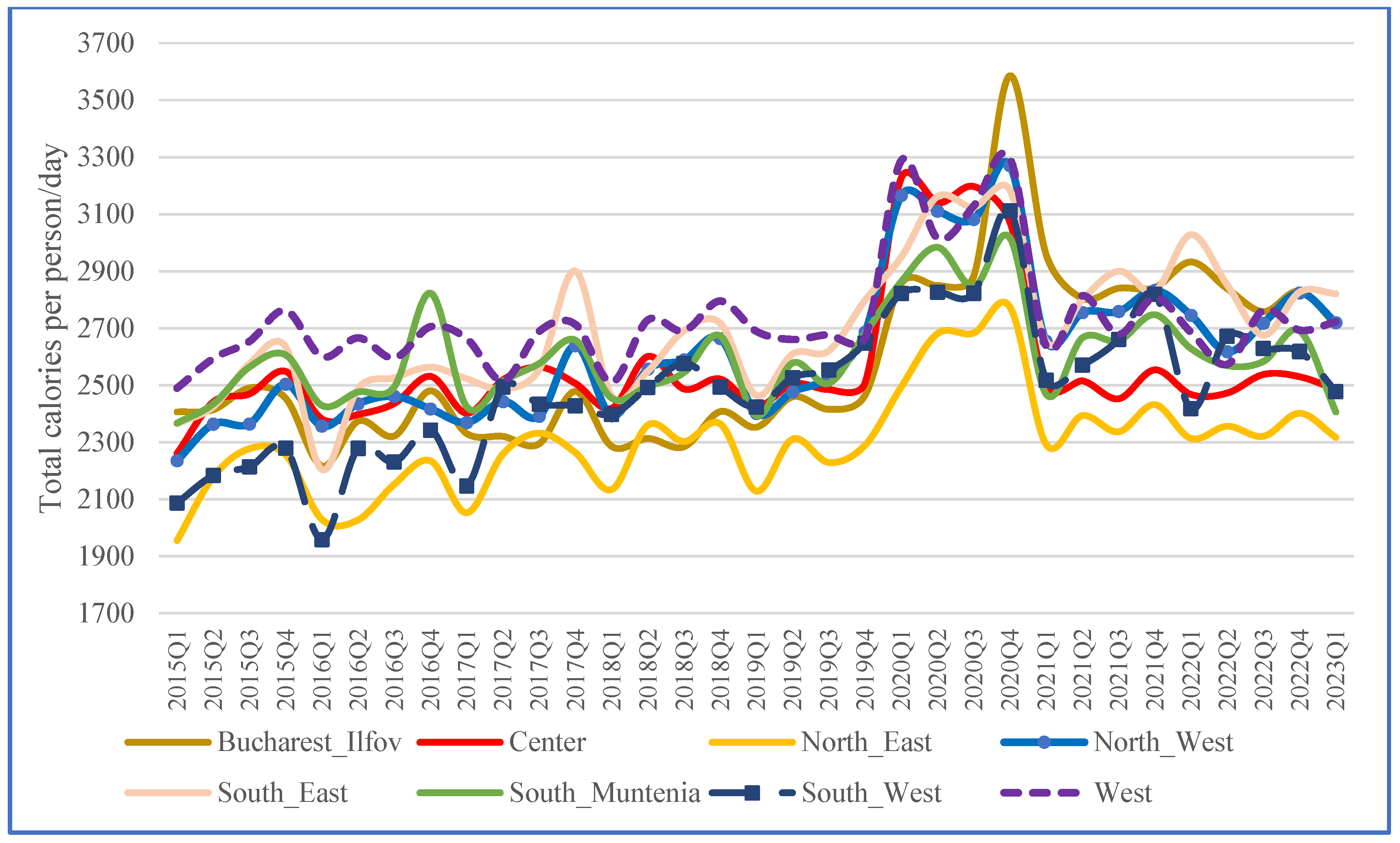
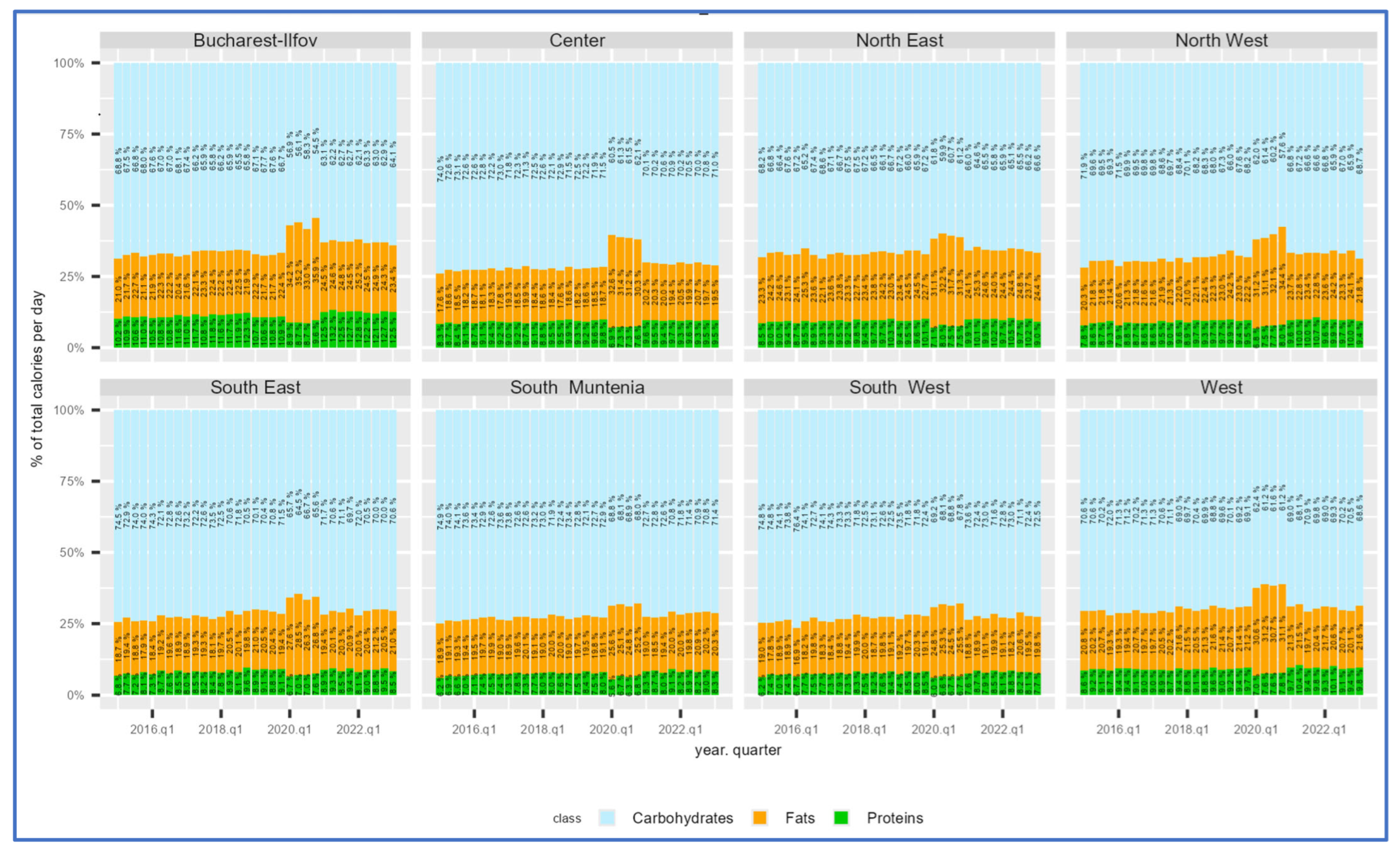
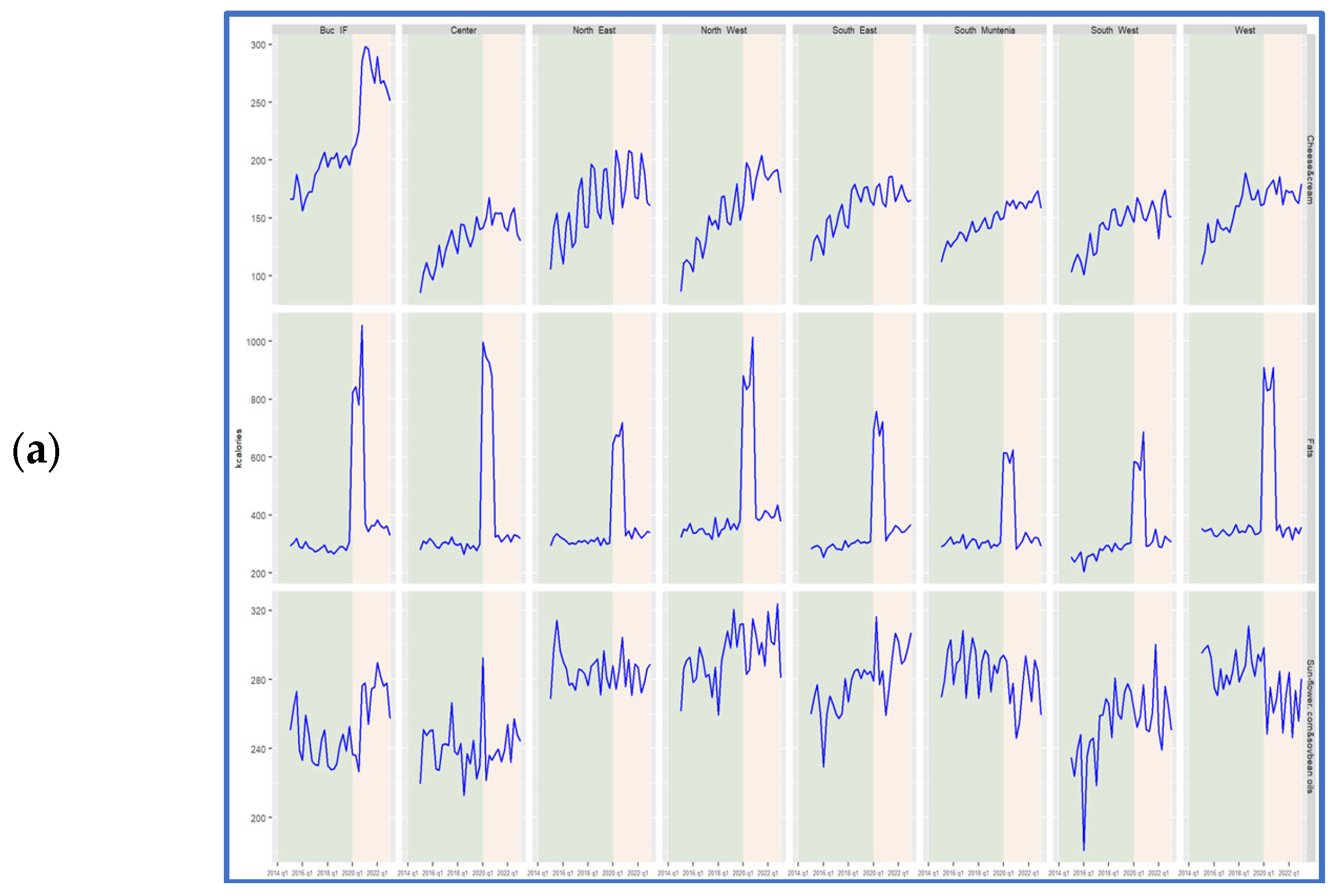
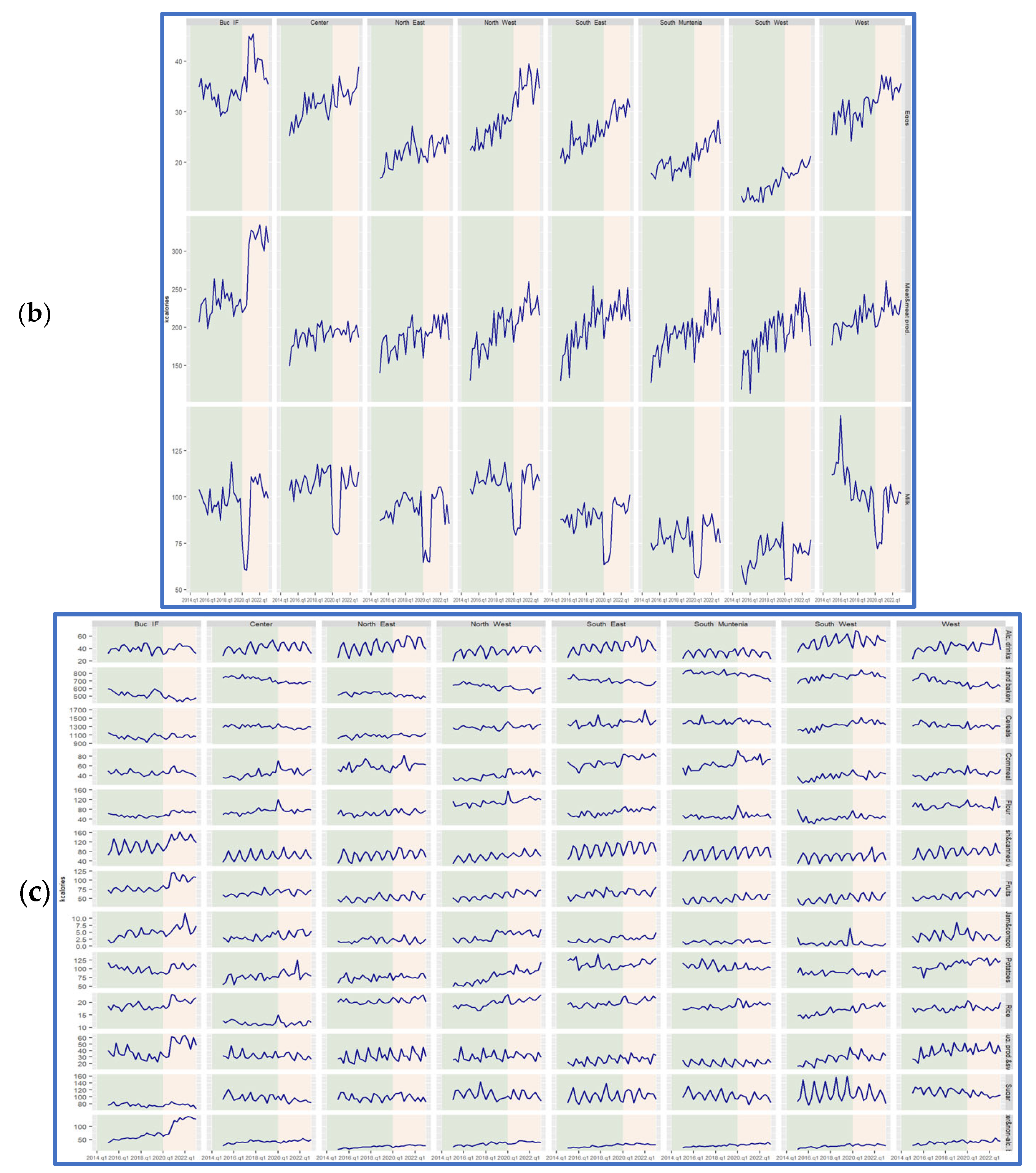
| Model | Category | Method | lncal | lnIPC | UR | lnIncome | Trimester | Regions | Cov19 | pCov19 | Validation | |||||||||||||||||||||
| AR1 | AR2 | AR3 | AR4 | t | t-1 | t-2 | t-3 | t | t-1 | t-2 | t | t-1 | t-2 | Jan–Mar. | Apr–Jun. | Jul–Sept | BIF | C | NE | NW | SE | S | SW | W | R2 | pDW | S-H | |||||
| 1 | Cereals | FE | −0.07 | −0.001 | 0.02 | −0.02 | −0.03 | −0.04 | 6.8 | 7.0 | 6.9 | 7.0 | 7.1 | 7.1 | 7.1 | 7.1 | 0.03 | 0.03 | 0.2 | *** | ||||||||||||
| 2 | GMM | 0.41 | 0.16 | 0.22 | 0.21 | −0.28 | 0.52 | −0.52 | 0.25 | 0.002 | −0.01 | 0.005 | 0.08 | −0.13 | 0.05 | −0.03 | −0.04 | −0.05 | 0.02 | 0.01 | p = 0.99 | |||||||||||
| 3 | Water& non-alcoholic beverages | FE | x | −0.02 | 0.57 | −0.06 | 0.21 | 0.04 | −0.6 | −0.92 | −1.4 | −1.1 | −1.2 | −1.2 | −1.3 | −1.0 | −0.08 | 0.01 | 0.8 | *** | ||||||||||||
| 4 | GMM | 0.50 | 0.19 | 0.15 | 0.16 | x | x | x | x | 0.001 | −0.01 | 0.01 | 0.34 | −0.34 | −0.004 | −0.04 | 0.06 | 0.03 | −0.07 | −0.03 | p = 0.99 | |||||||||||
| 5 | Bread & bakery prod. | FE | −0.04 | −0.003 | −0.07 | −0.03 | −0.02 | −0.02 | 6.9 | 7.2 | 6.9 | 7.1 | 7.2 | 7.3 | 7.3 | 7.2 | −0.01 | −0.02 | 0.4 | *** | ||||||||||||
| 6 | GMM | 0.54 | 0.20 | 0.08 | 0.20 | −0.32 | 0.30 | 0.20 | −0.11 | −0.01 | 0.01 | −0.003 | 0.04 | −0.04 | −0.01 | −0.03 | −0.02 | −0.02 | −0.0003 | 0.0001 | p = 0.99 | |||||||||||
| 7 | Cornmeal | FE | −0.08 | −0.01 | 0.22 | 0.04 | −0.04 | −0.04 | 1.9 | 2.0 | 2.3 | 1.8 | 2.5 | 2.4 | 1.9 | 2.0 | 0.14 | 0.04 | 0.4 | *** | ||||||||||||
| 8 | GMM | 0.38 | 0.27 | 0.11 | 0.17 | −0.51 | 0.13 | 1.7 | −1.6 | 0.01 | −0.03 | 0.03 | 0.20 | −0.18 | 0.004 | 0.07 | −0.04 | −0.07 | 0.10 | 0.03 | p = 0.99 | |||||||||||
| 9 | Flour | FE | 0.06 | −0.01 | 0.05 | −0.02 | −0.04 | −0.15 | 3.7 | 4.0 | 3.9 | 4.4 | 4.0 | 3.7 | 3.5 | 4.2 | 0.20 | 0.11 | 0.4 | *** | ||||||||||||
| 10 | GMM | 0.34 | 0.28 | 0.14 | 0.15 | −0.60 | 0.53 | 1.5 | −2.3 | −0.02 | 0.004 | 0.01 | 0.20 | −0.38 | 0.23 | −0.02 | −0.07 | −0.18 | 0.13 | 0.16 | p = 0.99 | |||||||||||
| 11 | Fresh & cannerd vegetables | FE | −0.28 | 0.01 | 0.43 | −0.45 | −0.16 | 0.14 | 1.1 | 0.7 | 0.89 | 0.7 | 1.2 | 0.91 | 0.7 | 1.0 | 0.02 | 0.03 | 0.8 | 0.7 | ||||||||||||
| 12 | GMM | 0.12 | 0.09 | 0.04 | 0.68 | −0.05 | −0.50 | 0.51 | 0.01 | −0.002 | −0.01 | 0.01 | 0.02 | −0.23 | 0.03 | −0.08 | 0.07 | 0.13 | 0.03 | −0.005 | p = 0.99 | |||||||||||
| 13 | Fruits | FE | 0.02 | −0.01 | 0.24 | −0.01 | −0.21 | −0.23 | 2.5 | 2.3 | 2.1 | 2.2 | 2.3 | 2.1 | 2.1 | 2.2 | 0.04 | 0.03 | 0.7 | *** | ||||||||||||
| 14 | GMM | 0.35 | 0.03 | 0.15 | 0.37 | −0.26 | 0.25 | 0.11 | −0.15 | 0.01 | −0.01 | 0.004 | 0.02 | −0.09 | 0.14 | −0.02 | −0.14 | −0.17 | 0.01 | −0.02 | p = 0.99 | |||||||||||
| 15 | Jam & compot | FE | −1.1 | −0.03 | 0.67 | 0.35 | −0.04 | −0.38 | −4.2 | −4.2 | −4.6 | −4.3 | −4.4 | −4.9 | −5.6 | −4.2 | 0.05 | −0.05 | 0.3 | *** | ||||||||||||
| 16 | GMM | 0.25 | −0.02 | 0.39 | 0.25 | −8.8 | 14.6 | −5.5 | 0.72 | −0.05 | 0.02 | −0.01 | 0.18 | −0.37 | 0.24 | 0.30 | 0.10 | −0.27 | −0.13 | −0.15 | p = 0.99 | |||||||||||
| 17 | Rice | FE | 0.12 | −0.01 | 0.11 | 0.003 | −0.04 | −0.04 | 2.8 | 2.3 | 2.9 | 2.9 | 2.9 | 2.8 | 2.7 | 2.7 | 0.06 | 0.04 | 0.4 | *** | ||||||||||||
| 18 | GMM | 0.55 | 0.16 | 0.15 | 0.12 | −0.24 | 0.23 | 0.62 | −0.78 | −0.01 | −0.003 | 0.01 | 0.04 | −0.13 | 0.10 | −0.01 | −0.06 | −0.05 | 0.04 | 0.03 | p = 0.99 | |||||||||||
| 19 | Potatoes | FE | −0.07 | 0.04 | 0.17 | −0.09 | −0.06 | −0.07 | 3.2 | 3.0 | 3.0 | 3.0 | 3.4 | 3.3 | 3.2 | 3.4 | 0.03 | 0.02 | 0.2 | *** | ||||||||||||
| 20 | GMM | 0.25 | 0.09 | 0.30 | 0.26 | 0.09 | −0.13 | −0.01 | 0.14 | 0.001 | −0.01 | 0.01 | 0.32 | −0.33 | 0.07 | −0.11 | −0.05 | −0.05 | 0.01 | −0.03 | p = 0.99 | |||||||||||
| 21 | Sugar products & sweets | FE | −0.26 | −0.01 | 0.20 | −0.24 | −0.31 | −0.49 | 2.2 | 2.1 | 2.1 | 2.0 | 1.9 | 1.7 | 2.0 | 2.3 | 0.03 | 0.07 | 0.6 | *** | ||||||||||||
| 22 | GMM | 0.40 | 0.18 | 0.17 | 0.18 | −0.50 | −0.03 | 1.4 | −1.1 | −0.01 | 0.03 | −0.02 | 0.20 | −0.29 | 0.15 | −0.34 | −0.35 | −0.49 | −0.01 | −0.03 | p = 0.99 | |||||||||||
| 23 | Sugar | FE | −0.04 | −0.003 | −0.08 | −0.11 | 0.01 | 0.11 | 5.1 | 5.3 | 5.3 | 5.3 | 5.3 | 5.3 | 5.4 | 5.4 | 0.05 | 0.02 | 0.5 | 0.05 | ||||||||||||
| 24 | GMM | 0.23 | −0.001 | 0.22 | 0.54 | −0.10 | 0.12 | −0.16 | 0.26 | −0.01 | 0.01 | 0.01 | 0.22 | −0.12 | −0.99 | −0.06 | −0.01 | 0.02 | 0.08 | 0.01 | p = 0.99 | |||||||||||
| 25 | Meat & meat products | FE | −0.30 | −0.01 | 0.32 | −0.17 | −0.04 | −0.09 | 2.9 | 2.7 | 2.8 | 2.7 | 2.8 | 2.7 | 2.8 | 2.8 | −0.05 | 0.05 | 0.7 | *** | ||||||||||||
| 26 | GMM | 0.36 | 0.25 | −0.08 | 0.39 | −1.8 | 0.40 | 2.3 | −0.73 | −0.001 | −0.01 | 0.01 | 0.17 | −0.22 | 0.11 | −0.10 | 0.02 | −0.02 | −0.04 | −0.003 | p = 0.99 | |||||||||||
| 27 | Milk | FE | −0.22 | −0.01 | 0.10 | 0.01 | −0.03 | −0.06 | 3.8 | 4.0 | 3.8 | 3.9 | 3.8 | 3.7 | 3.6 | 3.9 | −0.33 | 0.02 | 0.8 | *** | ||||||||||||
| 28 | GMM | 0.36 | 0.07 | 0.08 | 0.26 | −1.6 | 0.69 | 0.67 | 0.48 | −0.01 | 0.003 | 0.001 | −0.007 | −0.11 | 0.27 | −0.03 | −0.04 | −0.06 | −0.30 | −0.002 | p = 0.99 | |||||||||||
| 29 | Eggs | FE | −0.15 | −0.01 | 0.26 | −0.04 | −0.04 | −0.13 | 1.3 | 1.3 | 1.0 | 1.2 | 1.2 | 1.0 | 0.7 | 1.3 | 0.05 | 0.11 | 0.7 | *** | ||||||||||||
| 30 | GMM | 0.31 | 0.30 | 0.19 | 0.17 | −0.17 | 0.13 | 0.02 | 0.05 | −0.01 | 0.01 | 0.002 | 0.07 | −0.05 | 0.002 | −0.05 | −0.05 | −0.13 | 0.03 | −0.01 | p = 0.99 | |||||||||||
| 31 | Cheese & cream | FE | −0.29 | −0.01 | 0.49 | −0.02 | 0.07 | 0.07 | 1.1 | 0.8 | 1.2 | 0.94 | 1.1 | 1.0 | 1.0 | 1.0 | 0.01 | 0.01 | 0.8 | *** | ||||||||||||
| 32 | GMM | 0.51 | −0.14 | 0.34 | 0.24 | −0.46 | 0.55 | 0.51 | −0.90 | −0.004 | −0.003 | 0.01 | 0.10 | −0.06 | −0.006 | 0.00 | 0.05 | 0.03 | 0.02 | 0.005 | p = 0.99 | |||||||||||
| 33 | Fats | FE | −0.02 | 0.01 | 0.08 | −0.05 | −0.04 | −0.05 | 5.1 | 5.1 | 5.1 | 5.2 | 5.1 | 5.0 | 5.0 | 5.2 | 0.87 | 0.06 | 0.9 | *** | ||||||||||||
| 34 | GMM | 0.35 | −0.08 | 0.08 | 0.08 | −1.9 | 3.4 | −2.2 | 0.37 | 0.01 | −0.02 | 0.02 | 0.44 | −0.06 | 0.01 | −0.02 | 0.01 | −0.03 | 0.61 | −0.02 | p = 0.99 | |||||||||||
| 35 | Sun-flower, corn, soybean oils | FE | 0.01 | −0.01 | 0.01 | −0.03 | −0.03 | −0.02 | 5.5 | 5.4 | 5.6 | 5.6 | 5.6 | 5.6 | 5.5 | 5.6 | 0.01 | 0.01 | 0.1 | *** | ||||||||||||
| 36 | GMM | 0.31 | 0.21 | 0.24 | 0.21 | −0.19 | 0.31 | 0.16 | −0.46 | −0.01 | −0.001 | 0.01 | 0.20 | −0.22 | 0.04 | −0.03 | −0.04 | −0.03 | −0.003 | 0.02 | p = 0.99 | |||||||||||
| 37 | Total carbohydrates | FE | −0.01 | 0.03 | −0.05 | −0.04 | −0.03 | 7.1 | 7.2 | 7.1 | 7.2 | 7.3 | 7.3 | 7.2 | 7.3 | 0.03 | 0.03 | 0.4 | *** | |||||||||||||
| 38 | GMM | 0.40 | 0.13 | 0.20 | 0.27 | −0.01 | 0.001 | 0.01 | 0.13 | −0.18 | 0.05 | −0.06 | −0.04 | −0.04 | 0.02 | −0.002 | p = 0.99 | |||||||||||||||
| 39 | Total proteins | FE | −0.01 | 0.21 | −0.11 | −0.03 | −0.08 | 4.2 | 4.2 | 4.1 | 4.2 | 4.2 | 4.1 | 4.0 | 4.2 | −0.12 | 0.01 | 0.7 | *** | |||||||||||||
| 40 | GMM | 0.50 | 0.27 | −0.06 | 0.16 | −0.001 | −0.001 | 0.01 | 0.16 | −0.23 | 0.16 | −0.12 | −0.02 | −0.06 | −0.09 | −0.05 | p = 0.99 | |||||||||||||||
| 41 | Total fats | FE | 0.01 | 0.21 | −0.04 | −0.01 | −0.01 | 4.5 | 4.4 | 4.5 | 4.6 | 4.5 | 4.4 | 4.4 | 4.5 | 0.64 | 0.02 | 0.9 | *** | |||||||||||||
| 42 | GMM | 0.29 | 0.02 | 0.05 | 0.17 | −0.01 | 0.001 | 0.02 | 0.48 | −0.07 | −0.07 | −0.02 | 0.02 | −0.01 | 0.46 | −0.14 | p = 0.99 | |||||||||||||||
| 43 | Total food | FE | −0.002 | 0.09 | −0.06 | −0.03 | −0.03 | 7.1 | 7.1 | 7.0 | 7.1 | 7.2 | 7.1 | 7.1 | 7.2 | 0.17 | 0.02 | 0.8 | *** | |||||||||||||
| 44 | GMM | 0.40 | 0.14 | 0.18 | 0.28 | −0.01 | −0.001 | 0.01 | 0.20 | −0.17 | −0.02 | −0.06 | −0.03 | −0.04 | 0.12 | −0.02 | p = 0.99 | |||||||||||||||
| − | Significant at p < 0.001 | − | Significant at p < 0.01 | − | Significant at p < 0.055 | *** serial correlation significant at p < 0.001 | ||||||||||||||||||||||||||
| + | + | + | ||||||||||||||||||||||||||||||
Disclaimer/Publisher’s Note: The statements, opinions and data contained in all publications are solely those of the individual author(s) and contributor(s) and not of MDPI and/or the editor(s). MDPI and/or the editor(s) disclaim responsibility for any injury to people or property resulting from any ideas, methods, instructions or products referred to in the content. |
© 2025 by the authors. Licensee MDPI, Basel, Switzerland. This article is an open access article distributed under the terms and conditions of the Creative Commons Attribution (CC BY) license (https://creativecommons.org/licenses/by/4.0/).
Share and Cite
Pană, A.; Strilciuc, Ș.; Ileanu, B.-V. Dietary Disruptors in Romania: Seasonality, Traditions, and the COVID-19 Pandemic. Nutrients 2025, 17, 183. https://doi.org/10.3390/nu17010183
Pană A, Strilciuc Ș, Ileanu B-V. Dietary Disruptors in Romania: Seasonality, Traditions, and the COVID-19 Pandemic. Nutrients. 2025; 17(1):183. https://doi.org/10.3390/nu17010183
Chicago/Turabian StylePană, Adrian, Ștefan Strilciuc, and Bogdan-Vasile Ileanu. 2025. "Dietary Disruptors in Romania: Seasonality, Traditions, and the COVID-19 Pandemic" Nutrients 17, no. 1: 183. https://doi.org/10.3390/nu17010183
APA StylePană, A., Strilciuc, Ș., & Ileanu, B.-V. (2025). Dietary Disruptors in Romania: Seasonality, Traditions, and the COVID-19 Pandemic. Nutrients, 17(1), 183. https://doi.org/10.3390/nu17010183







